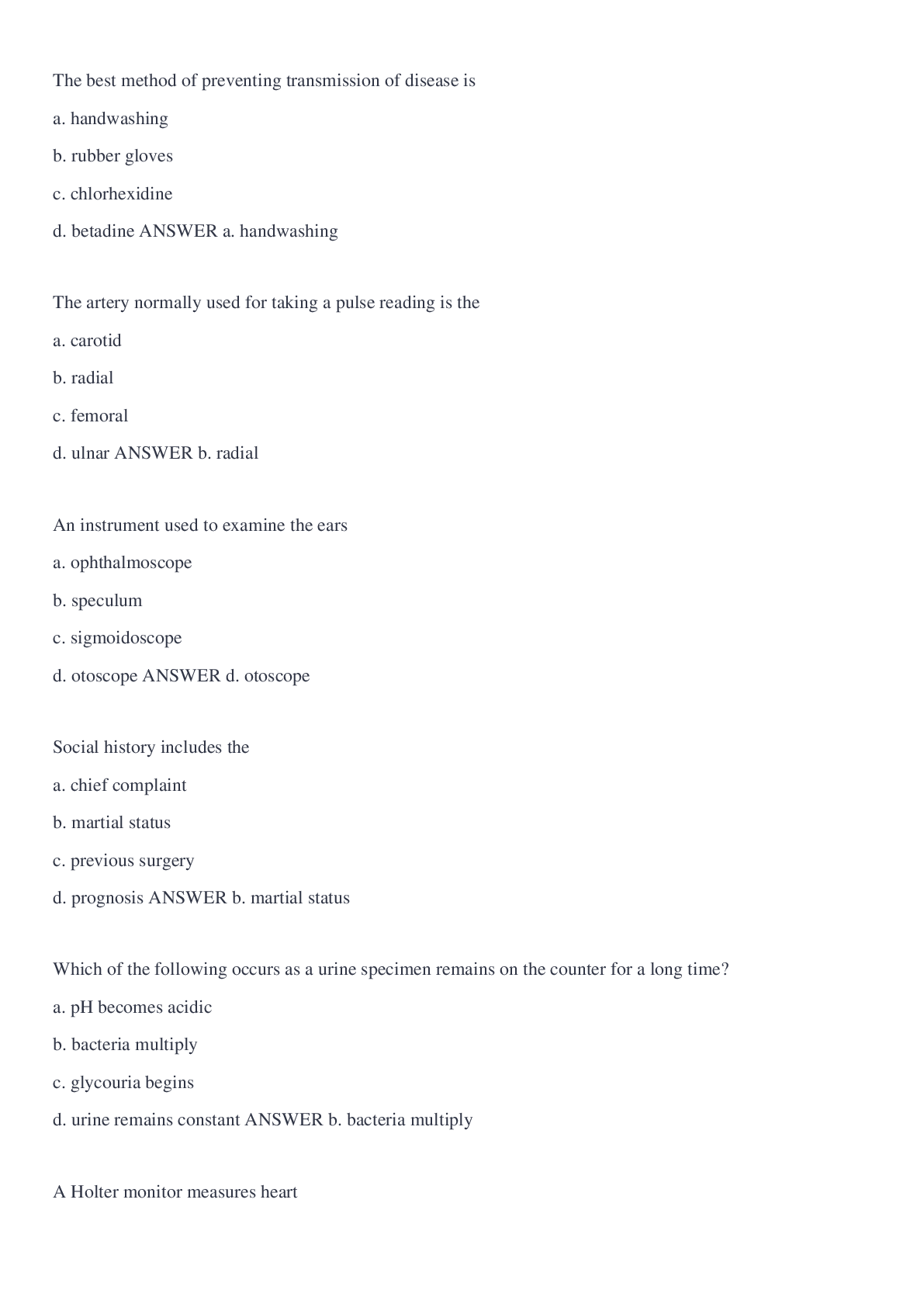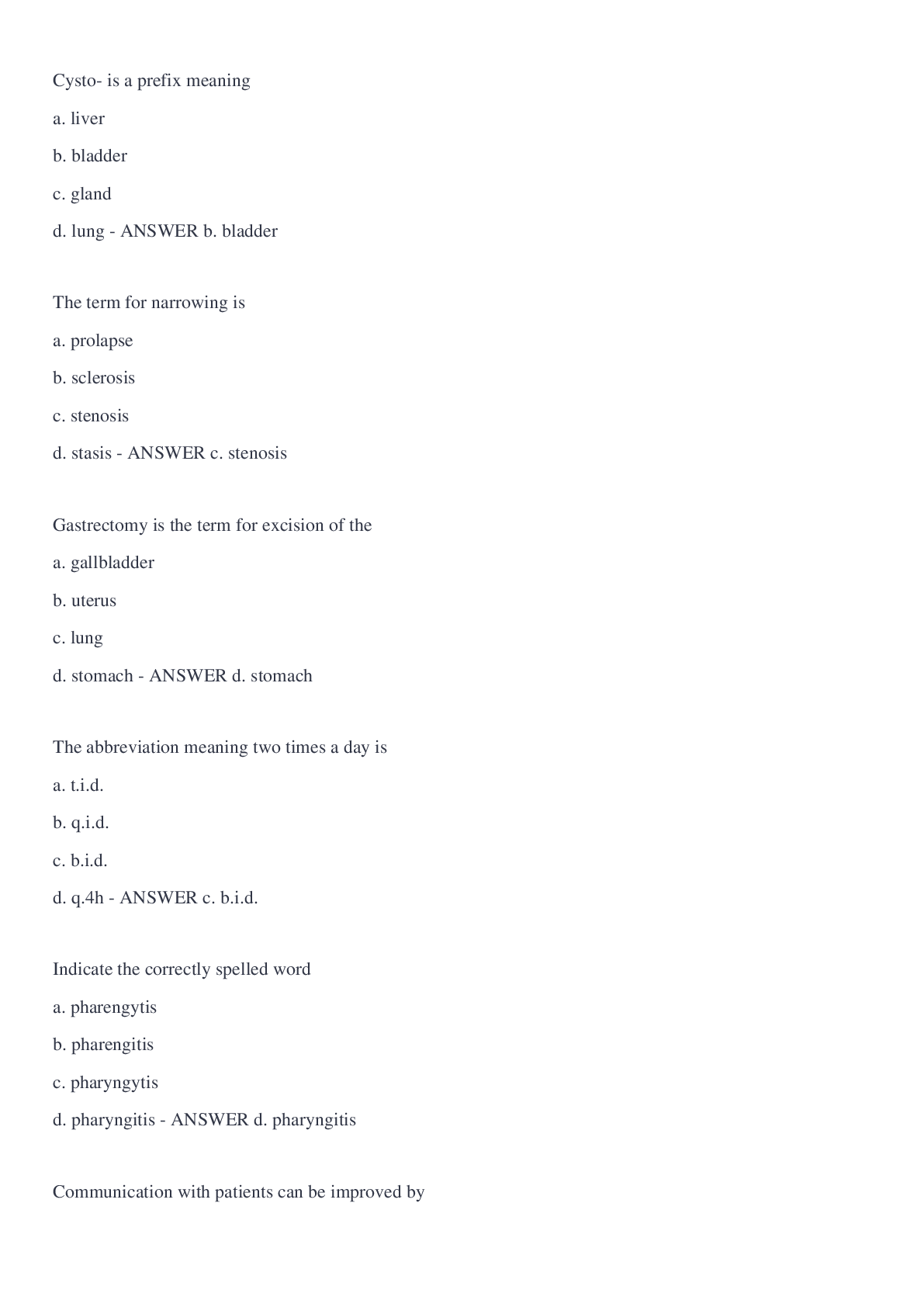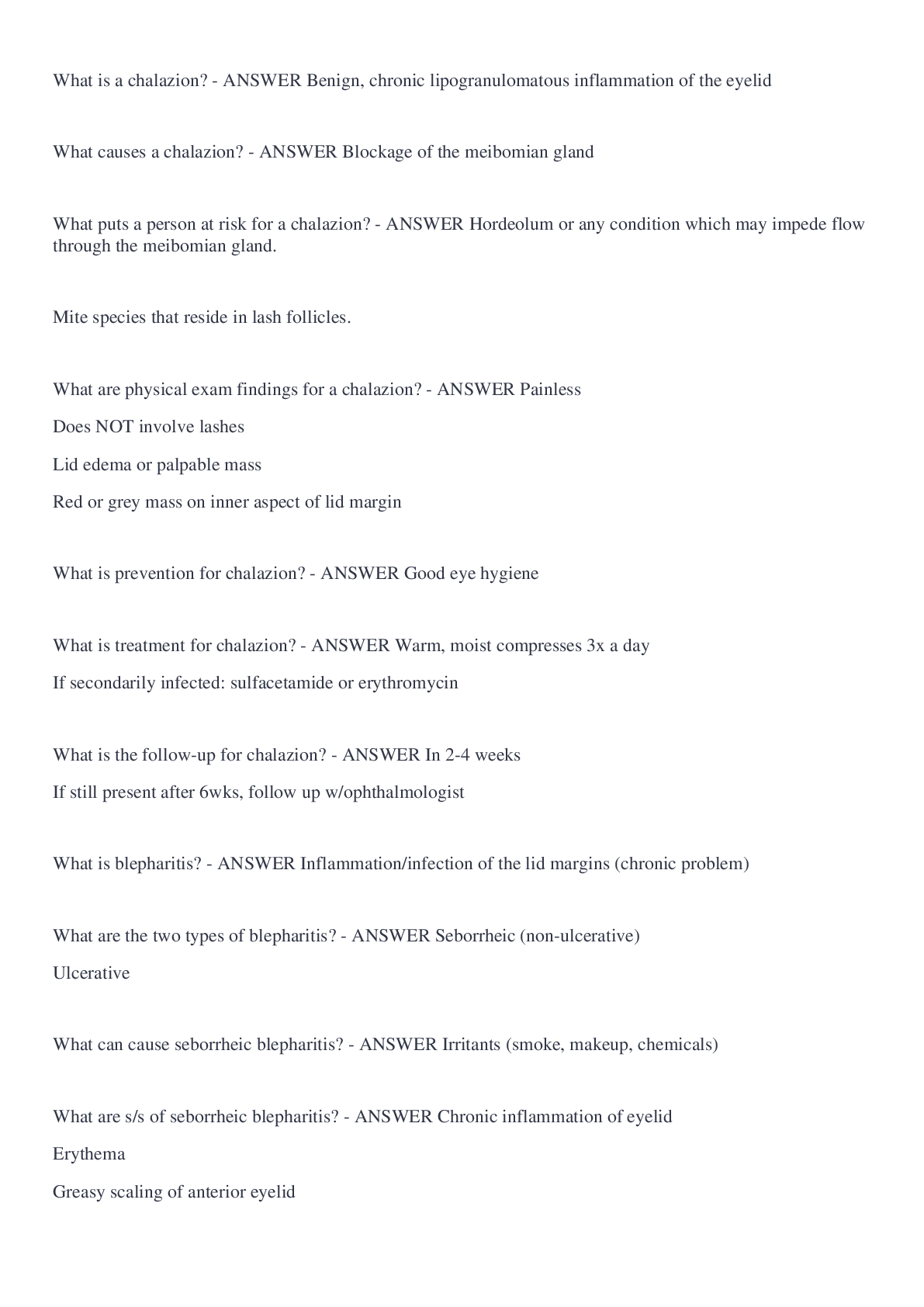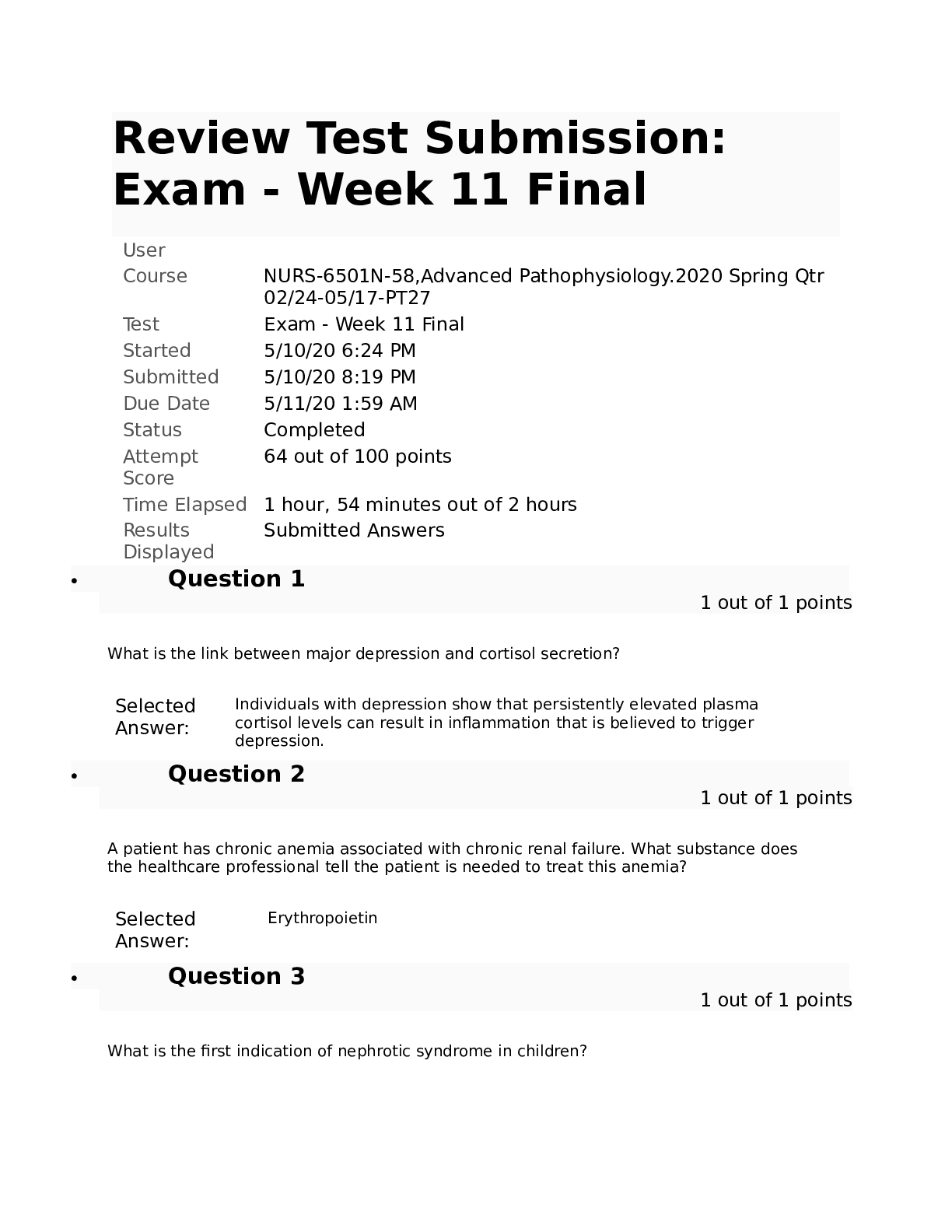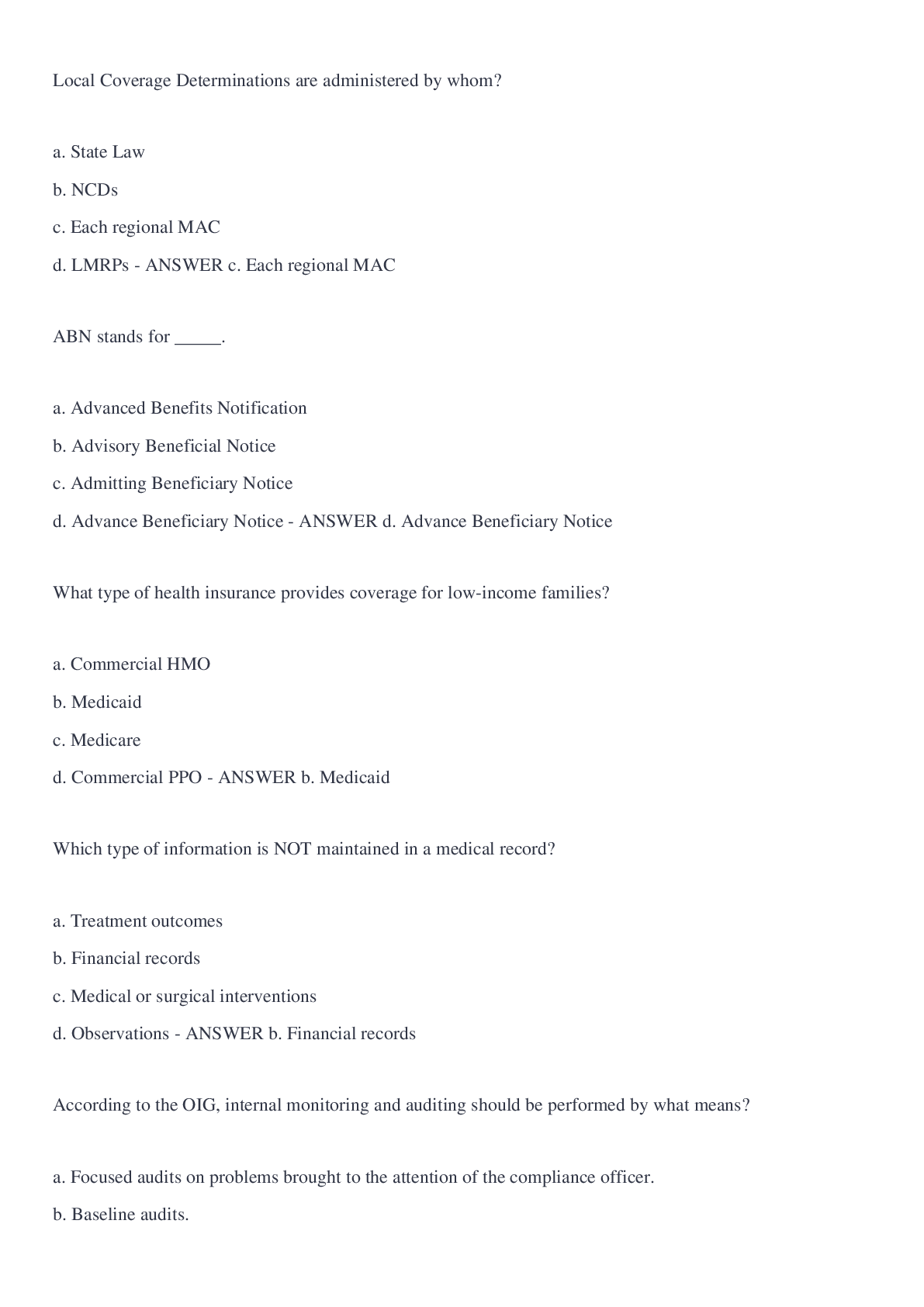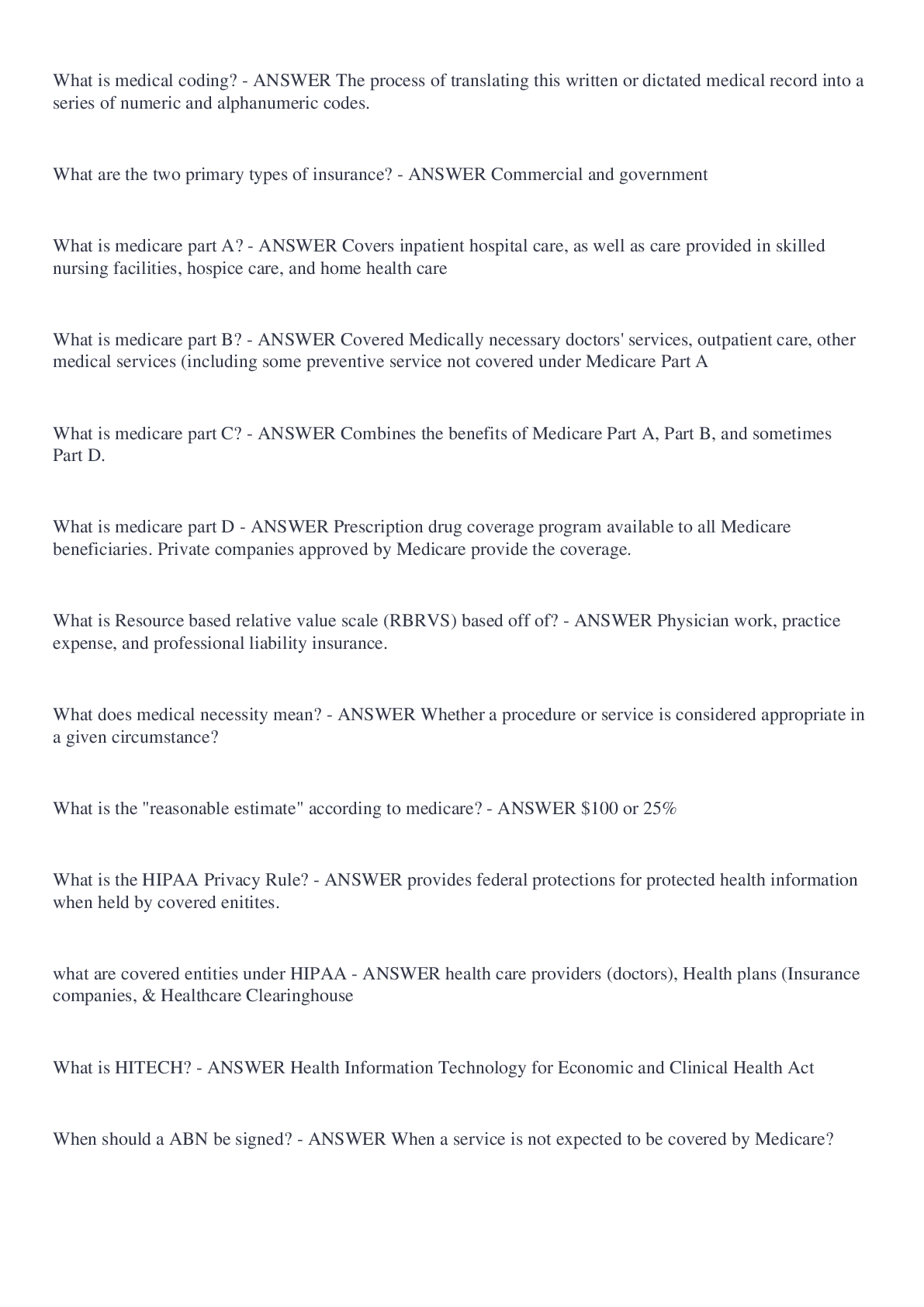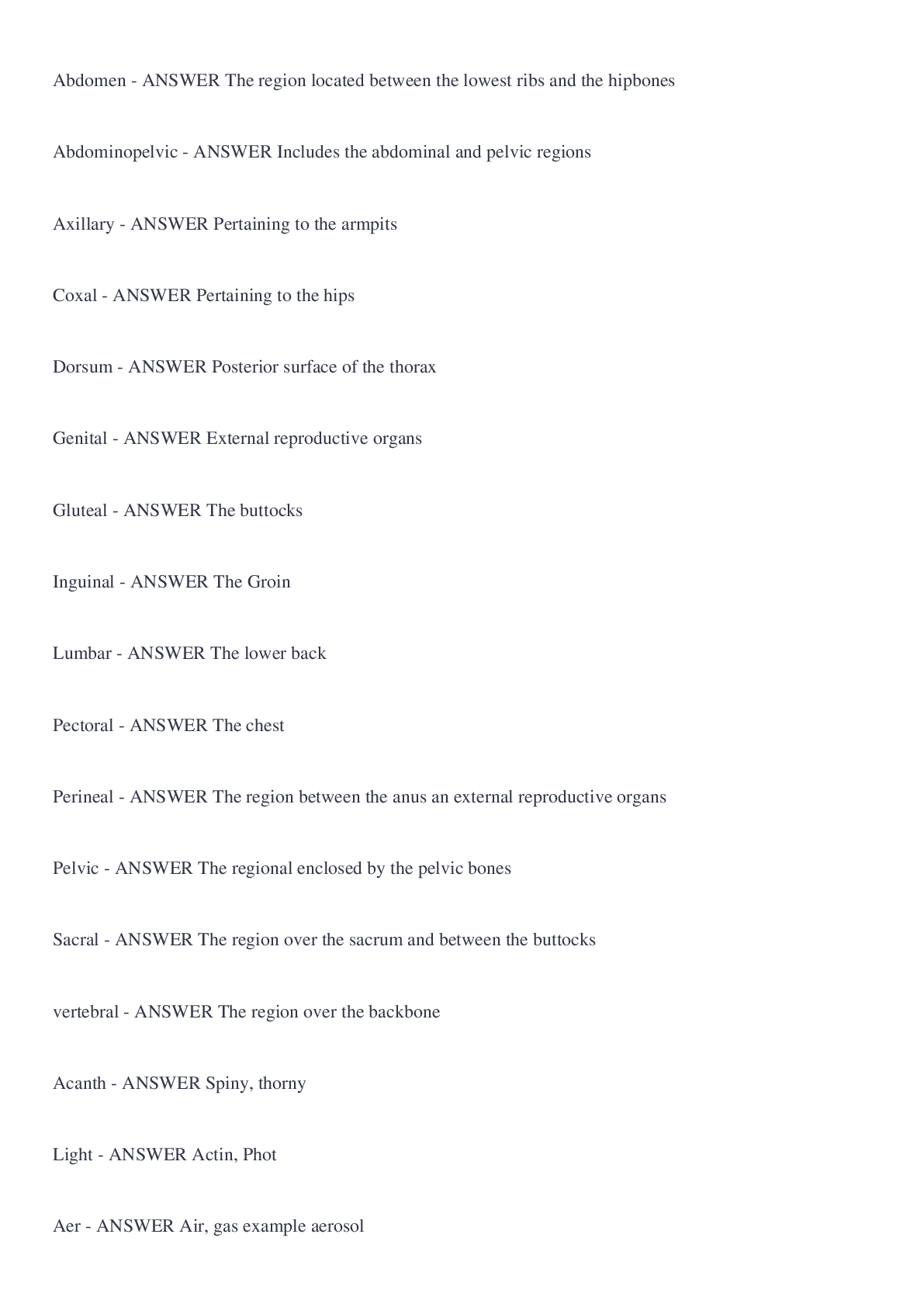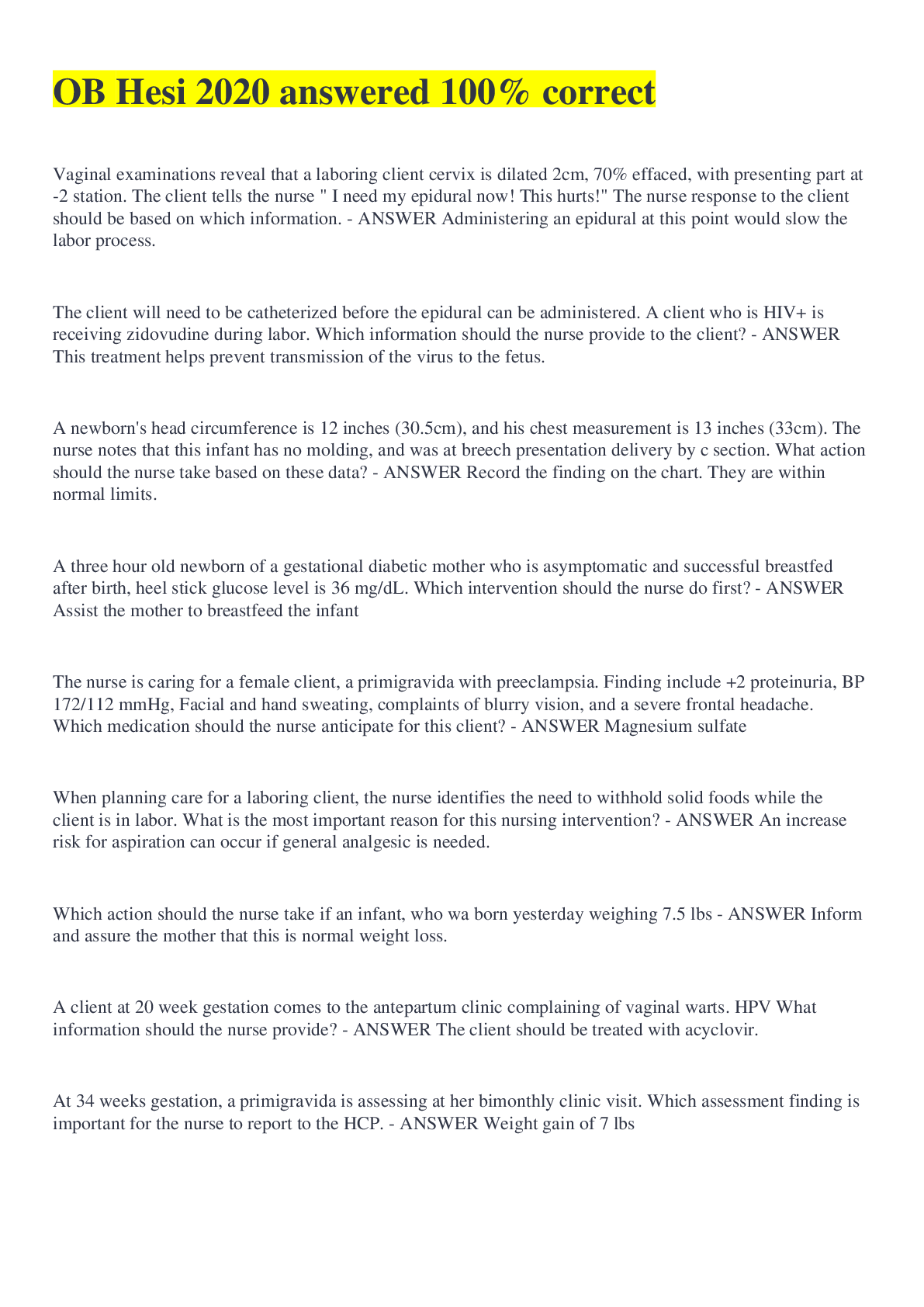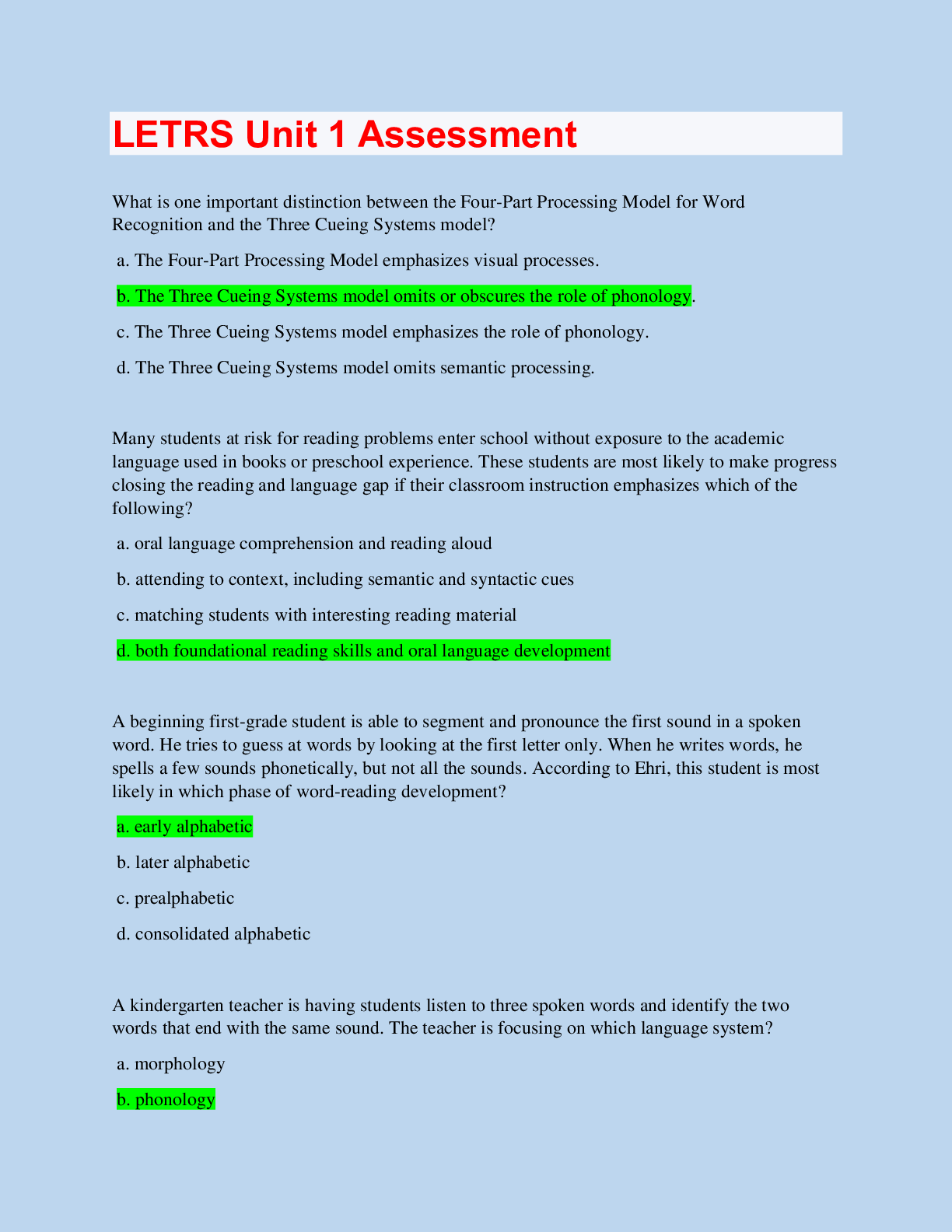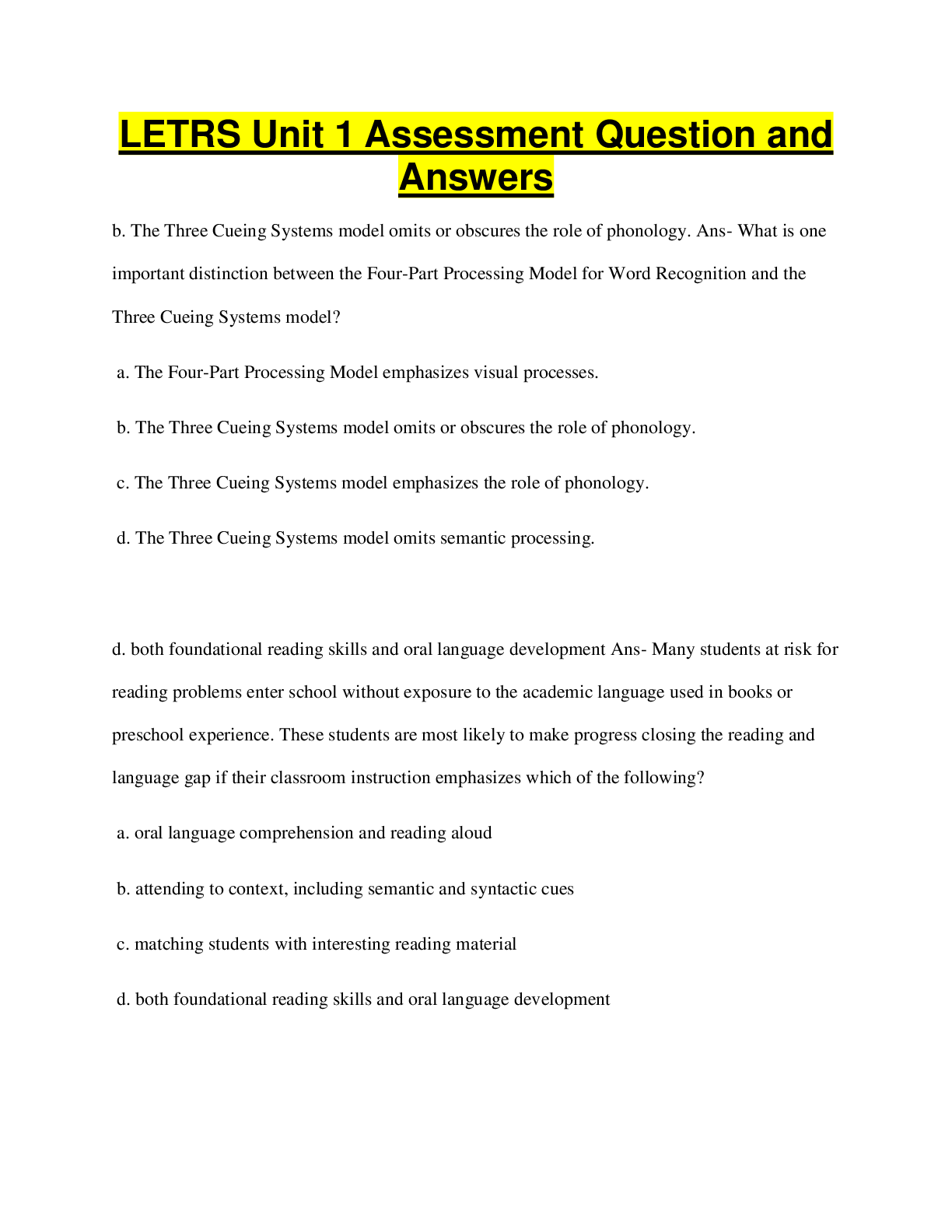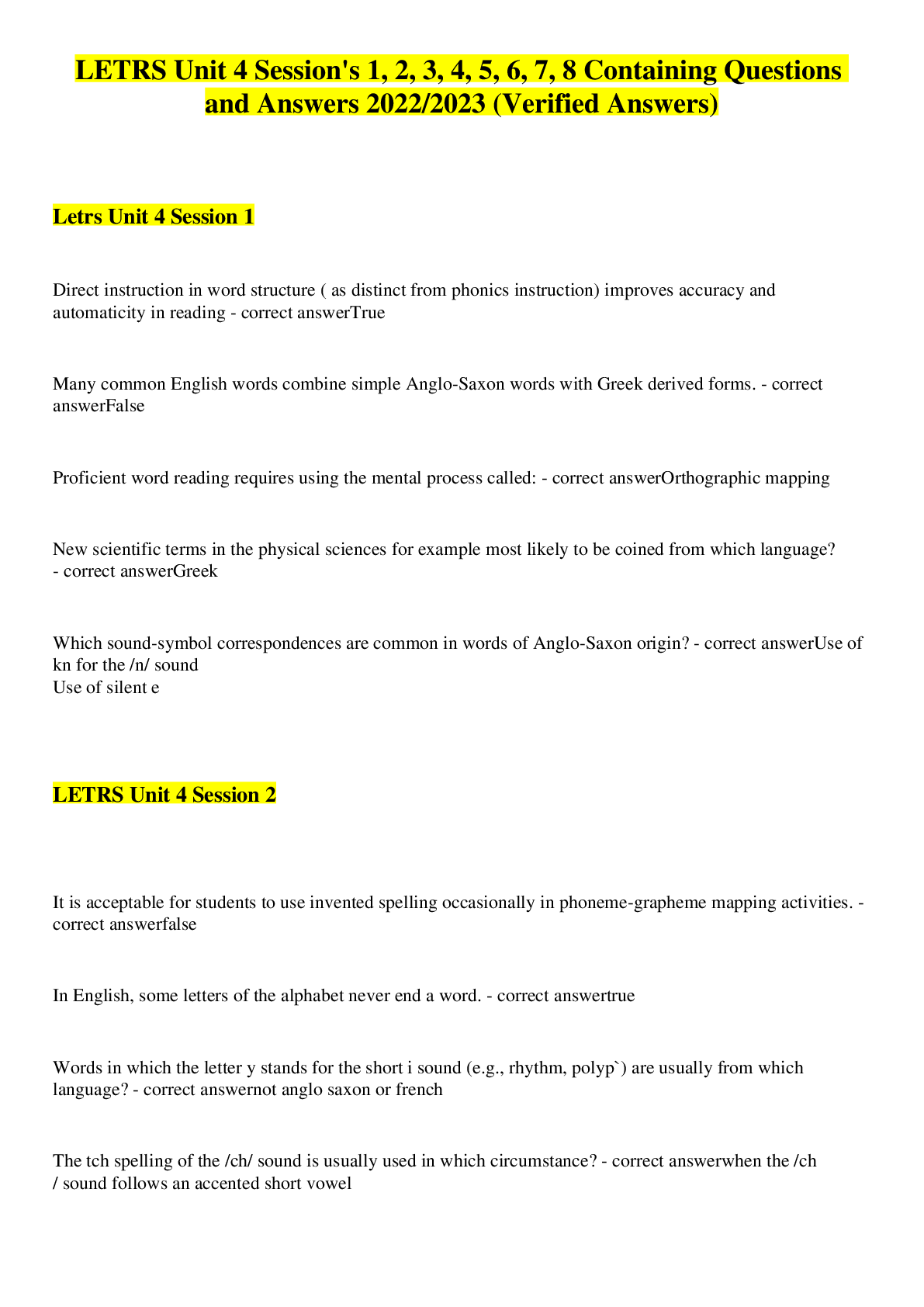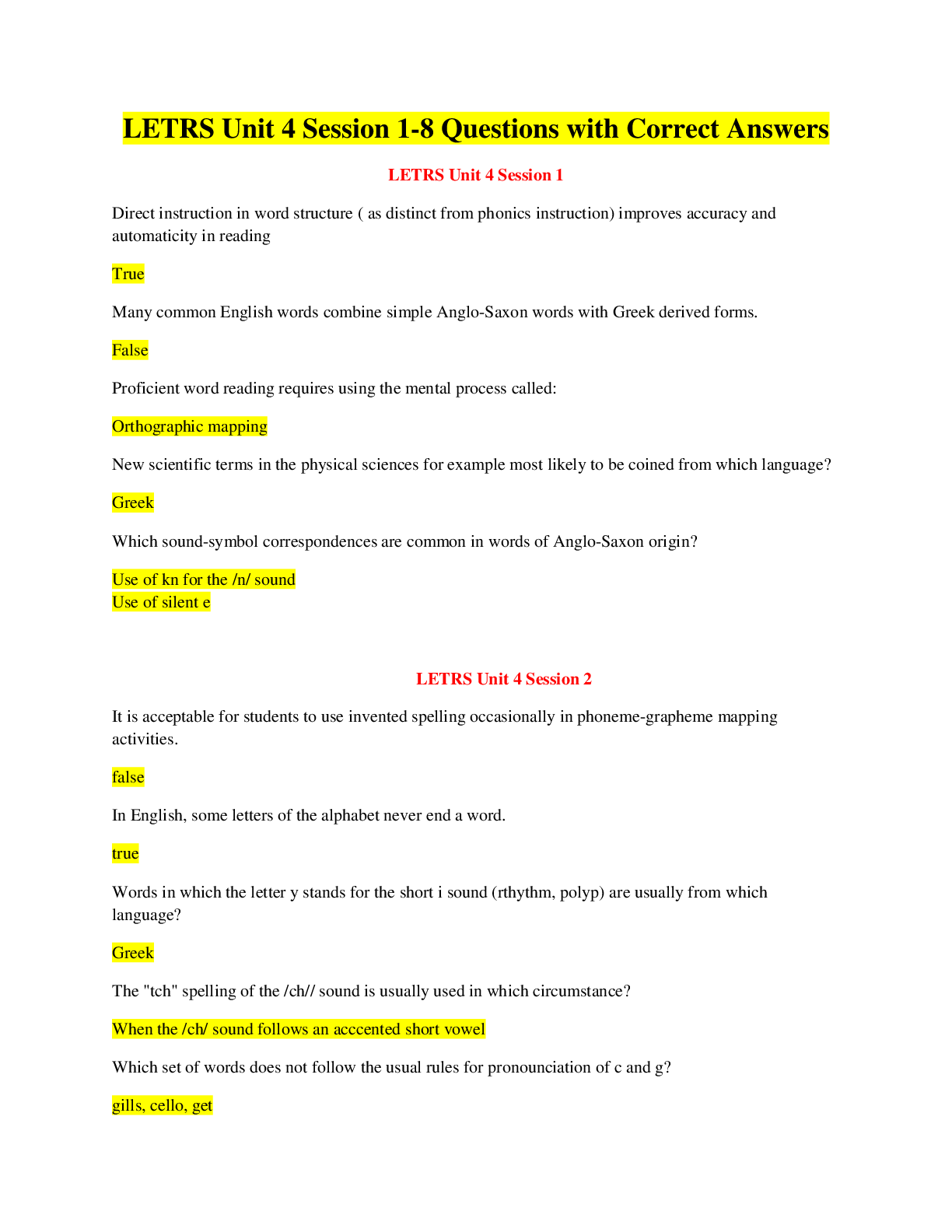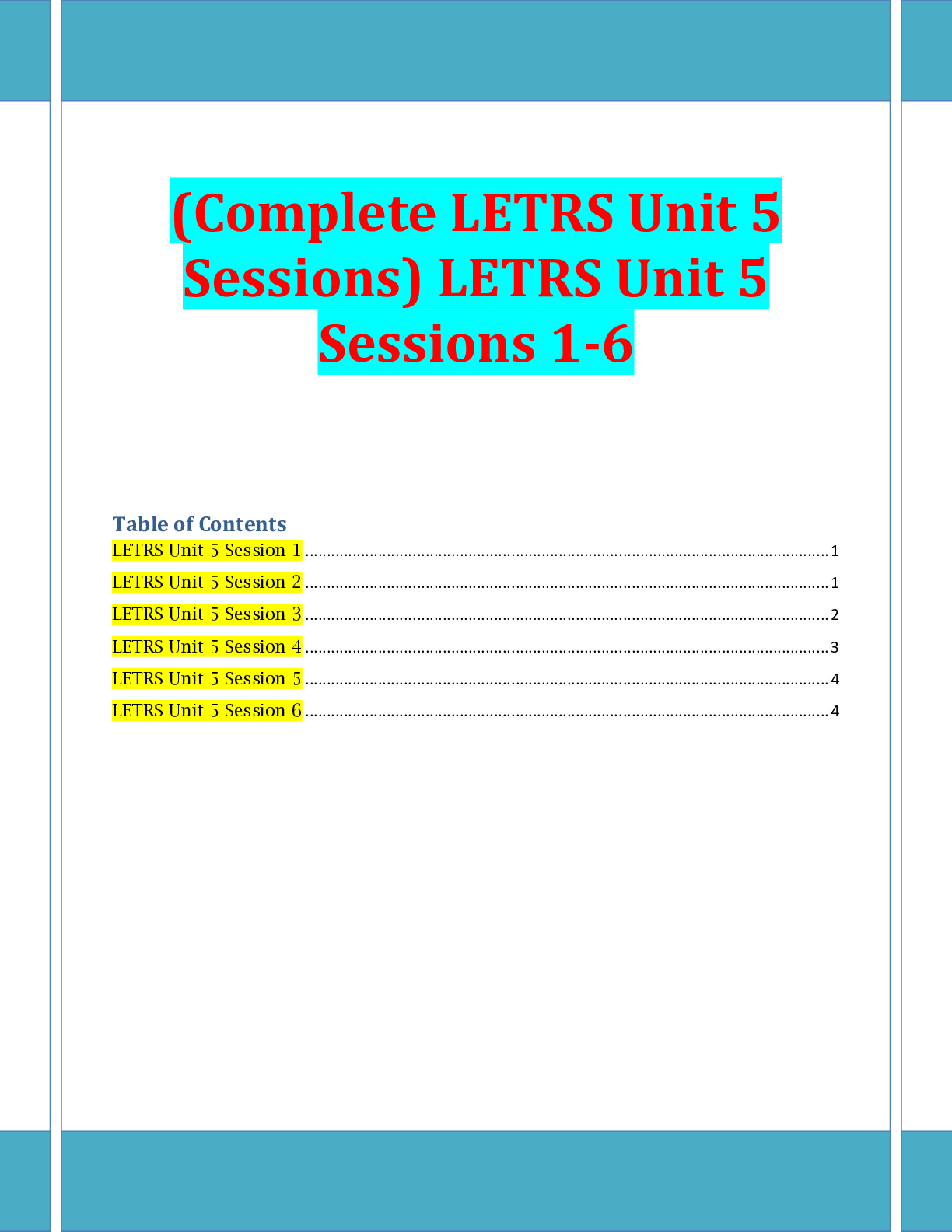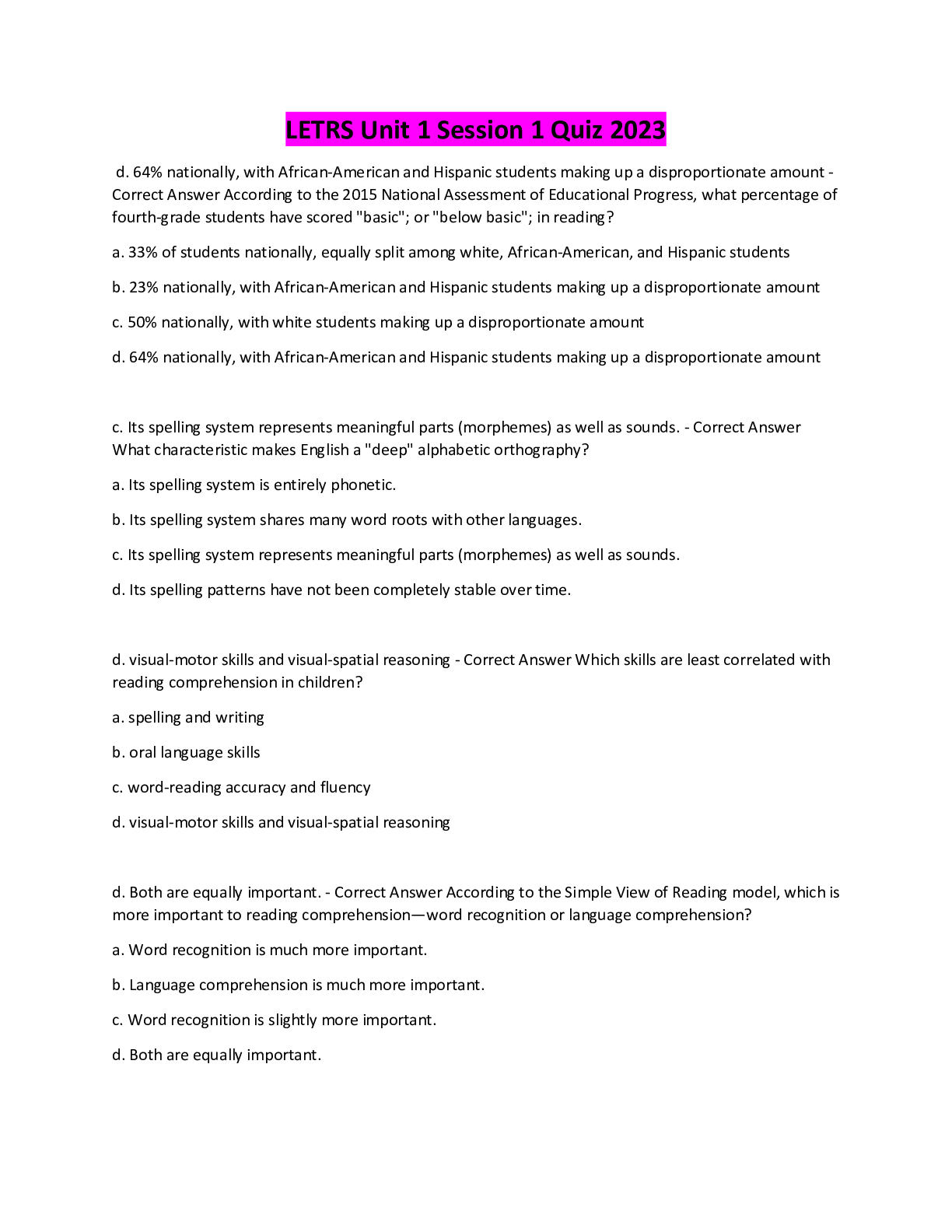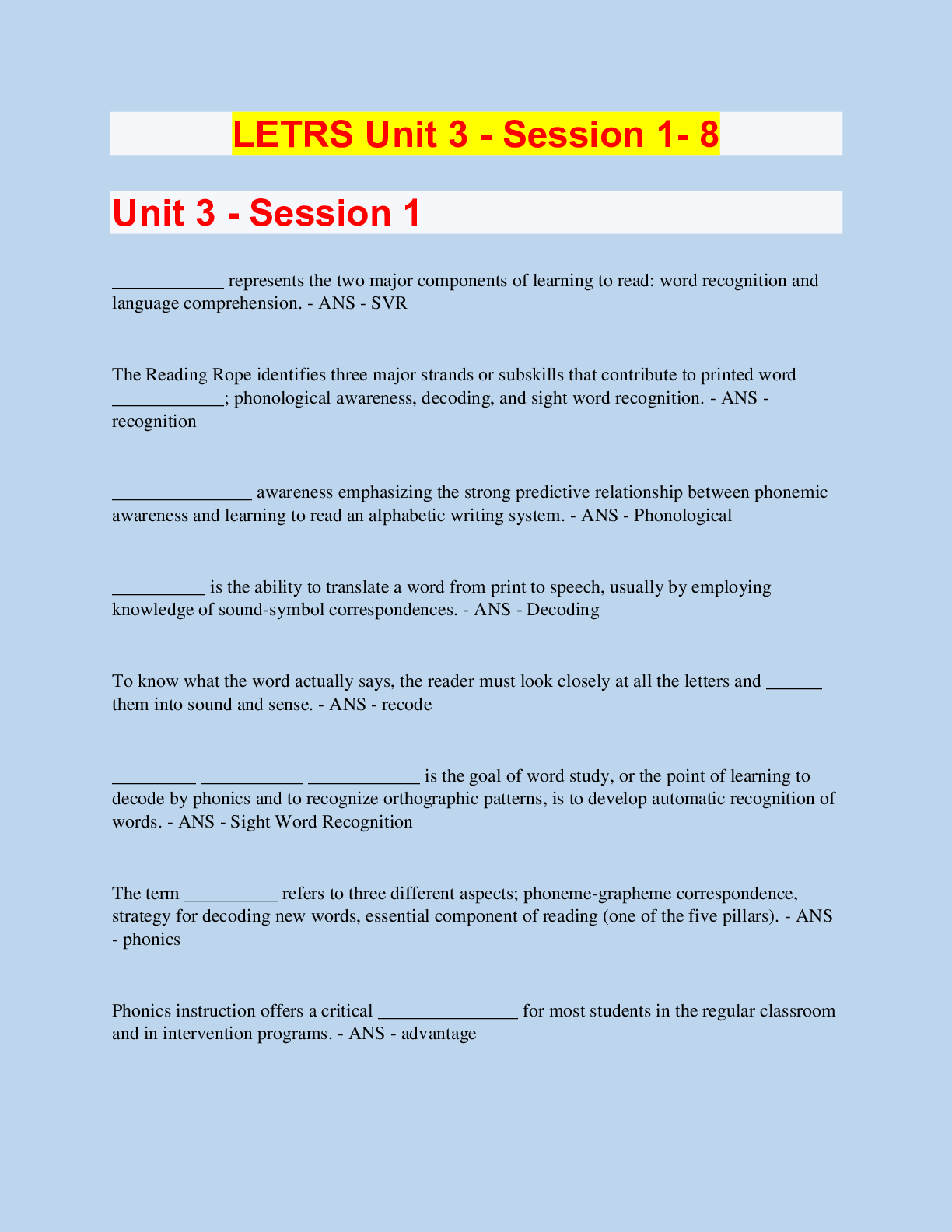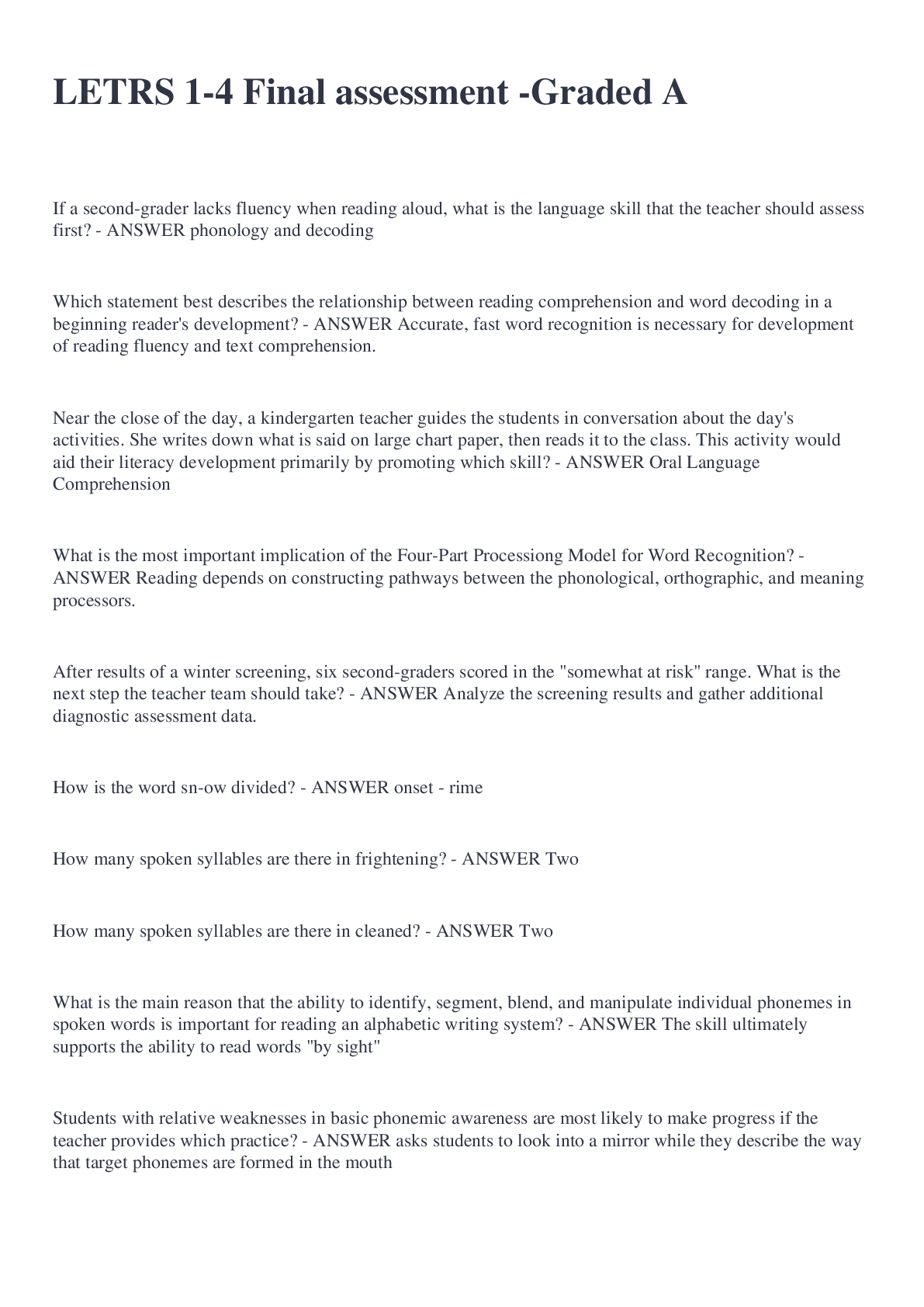Portage Learning chem 210 exams 1-8 and final exam.
Document Content and Description Below
Question 1 3 / 3 pts True or False: According to the Module, a compound with a molecular mass of 1,000 g/mol is considered a macromolecule. True Correct! False Question 2 3 / 3 pts True or Fa... lse: Biomolecules can have only two functional groups. True Correct! False Question 3 3 / 3 pts True or False: The following functional group is an alcohol. True Correct! False Question 4 3 / 3 pts Portage Learning Chem 210 Exam 1-8 and Final Exam. True or False: In a eukaryotic cell, the organelles called peroxisomes serve the purpose of digesting macromolecules. True Correct! False Question 5 3 / 3 pts True or False: Carbon dioxide has a linear molecular shape AND has a bond angle of 109.5o . True Correct! False Question 6 3 / 3 pts Of the following, ____________ is not a property of carbon. forming covalent bonds triple bond formation Correct! possessing five valence electrons reacting to form long chains called polymers forming multiple bonds Question 7 3 / 3 pts Which of the following is an element not typically found in living organisms? N Correct! He H S O Question 8 3 / 3 pts _____________ is a functional group found in carbohydrates. Esters Thiols Carboxylic acids Correct! Alcohols Amines Question 9 3 / 3 pts The following functional group is an example of _________. Correct! Ketone Thiol Amide Benzene Aldehyde Question 10 0 / 3 pts A ___________ is a chemical formula that does NOT show the C-H and C-C bonds. You Answered Covalent formula Line bond formula Empirical formula Kekule’ structure Correct Answer Condensed formula Question 11 3 / 3 pts A collection of two or more macromolecules uniting is called a _______. Correct! Supramolecular complex Monomer Macromolecular structure Dimer Kekule’ complex Question 12 3 / 3 pts An organic compound with this structure, C=C, contains a ________ functional group. Alkane Correct! Alkene Alkyne Alcohol Both b and d Question 13 3 / 3 pts Scientists refer to ________ as the “super glue” of the chemistry. Correct! C Co Na N O Question 14 3 / 3 pts What molecule is most important for energy storage in cells? Creatine mitochondria DNA RNA Correct! ATP Question 15 3 / 3 pts What would be the approximate size of a human cell? a. 12 μ m b. 1 nm c. 15 nm d. 0.2 inch e. 15 cm Correct! a. b. c. d. e. Question 16 3 / 3 pts For propane, there ________ carbon and ________hydrogen atoms. 5, 12 4, 10 Correct! 3, 8 3, 6 None of the above Question 17 3 / 3 pts For an organic compound, which structure is the most efficient to draw? Correct! Line bond Condensed Lewis structure Structural formula None of these Question 18 3 / 3 pts When writing an organic functional group, scientists often write an “R” as part of the structure. What does the R indicate? A string of carbon atoms Radon Routine carbon atom Correct! Rest of the molecule None of the above Question 19 3 / 3 pts According to the module, the study of NON-carbon compounds is referred ____. Organic chemistry Correct! Inorganic chemistry Biochemistry Environmental chemistry None of the above. Question 20 3 / 3 pts Which of the following is not a functional group discussed in this module? Alcohol Amine Ketone Aldehyde Correct! All of these were discussed. Question 21 3 / 3 pts Which number would be closest to the approximate number of ribosomes in an E. coli cell? A. 1 B. 25 C. 250 Correct! D. 25,000 E. Both c and d Question 22 0 / 3 pts Which of the following would most likely have a cell wall? Correct Answer Marigold flower cells Deer cells Heart cells Human red blood cells You Answered All of the above Question 23 0 / 3 pts Eukaryotes have molecules that provide protective structural. This network is called the _____________. Cell wall You Answered Cytoplasm Cytosol Correct Answer Cytoskeleton Both Cell wall and Cytoskeleton Question 24 3 / 3 pts The molecule linked to the medical condition of gout is __________. Correct! Uric acid Luciferin Luciferase Glucose Glycine Question 25 3 / 3 pts About how many different elements are found in living organisms? 9 Correct! 30 50 68 92 Question 26 3 / 5 pts (Short response) Explain the common similarity in all prokaryotic and eukaryotic cells. Give a brief explanation of the similarity. Your Answer: The common similarity between prokaryotic and eukaryotic cells are they both contain cells, a cell membrane and ribosomes. The fundamental similarity is that each cell type has a plasma membrane that separates life from non-life. The plasma membrane acts as a barrier to most molecules but does have proteins that permit select molecules to cross via proteins (transporters). The plasma membrane permits the cell to have a different composition of molecules inside the cell than out and defines a space for life to occur. Develop the membrane response further, based on module material. Question 27 2.5 / 5 pts (Short response) Would scientists be more likely to find an element such as O in a biomolecule, or W? Explain which she would more likely find in biological molecule and give specific physical/chemical properties. Your Answer: Scientists would be more likely to find an element of O in a biomolecule because O is a bulk element while W is a trace element. O is found is most strcutures and functional groups. She would more likely find O. Smaller elements are preferred. In the case of O, it is found in water, so it would be highly concentrated. Smaller elements with smaller atomic shells are favored because they can form stable covalent bonds. Strong bonds form by significant overlap of atoms, such as carbon and hydrogen permitting them to share electrons. The bond that forms requires a substantial amount of energy to break, which allows the bonds to withstand insults, such as mechanical and thermal stresses. This bond strength is good news for living organisms. Stable bonds allow cells to form, hair to grow, and skin to protect against abrasion. Larger elements, such as W, tend to form ionic compounds–not covalent. Describe why O is using the size/overlap. Question 28 3.5 / 5 pts (Short response) What element is the basis for life? Describe at least two properties of this element that permit it to serve the basis for life. Your Answer: Carbon is the element that is the basis for life. Carbon has the ability to form stable covalent bonds and unique combinations. Carbon has its own branch organic chemistry. 1. Carbon can form strong covalent bonds with a variety of different elements. 2. Besides, carbon can form double and triple bonds with other carbon atoms and other elements (N and o). 3. Carbon can form long chains by forming numerous carbon-carbon bonds; we call these large molecules polymer. 4. Lastly, carbon can form cyclic structures, which are also called ring compounds. Give one more property of carbon. Question 29 4 / 5 pts (Short response) How does organic chemistry differ from inorganic chemistry? Your Answer: Organic chemistry is focues on the chemical and physical properties of carbon and inorganic chemistry focues on non organic compounds. Organic chemistry is the study of the carbon-based compounds. Inorganic chemistry is the study of all other elements, but carbon. There is no need to have separate sub-disciples for organic and inorganic chemistry, but for historical and organizational reasons the difference exists. Include the non-carbon elements in your defintion of inorganic. Question 30 0 / 5 pts (Short response) Biochemists study the communication within and among organisms. According to the module, what are two other aspects of living organisms that biochemists study? Your Answer: Bichemists study carbs and proteins in living organism along with chemistry and biology. Also luciferin i studies and luciferase. In the module, biochemists also study the structure and function of biomolecules and the chemical reactions of organisms. Be more specific here. This is related to the homework problems and module material. EXAM 2 Question 1 3 / 3 pts The pH of a solution of 0.0010 M NaOH is: 1 Correct! 11 [Kw=[H+ ][OH- ] = 1.0 x 10-14; [H+ ][0.0010] = 1.0 x 10-14 [H+ ]=1.0 x 10-11; pH=-log[1.0 x 10-11;]=11] 8 0 14 Question 2 3 / 3 pts Water is a unique molecule. Which of the following contributes to water’s unique place in the chemical world? The geometry of the molecule The polarity of the O-H bonds The ability of water molecules to hydrogen bond The bond angle of water Correct! All of the answers are correct Question 3 0 / 3 pts The bent shape of water is due to ______________. The dipole arrows in a water molecule The electronegativity difference between hydrogen and oxygen You Answered The unequal electron sharing between hydrogen and oxygen Correct Answer The unshared electron pairs on the oxygen atom None of the answers are correct Question 4 0 / 3 pts Which diagrams correctly represent a hydrogen bond? Correct Answer A and D A and C You Answered B and C C and D B and D Question 5 0 / 3 pts The H+ concentration of a solution is 1.2 x 10-3 M. What is the pH? -1.20 1.20 You Answered 3.12 -2.92 Correct Answer 2.92 Question 6 3 / 3 pts If the Ka of an acid is 5.63 x 10-3, what is the pKa? 6.86 Correct! 2.25 [pKa = -log(5.63 x 10-3) = 2.25] 5.63 10.12 1.38 Question 7 3 / 3 pts List the acids in DECREASING order of strength (strongest to weakest): Nitrous acid (Ka = 4.0 x 10-4); acetic acid (Ka = 1.7 x 10-5); phosphoric acid (Ka = 7.3 x 10-3) Nitrous acid, acetic acid, phosphoric acid Acetic acid, nitrous acid, phosphoric acid Correct! Phosphoric acid, nitrous acid, acetic acid Acetic acid, phosphoric acid, nitrous acid None of the above Question 8 0 / 3 pts Elemental iodine (I2) is a solid at room temperature. What is the dominant attractive force that exists between I2 molecules in the solid? Correct Answer London forces Hydrogen bonds Halogen forces You Answered Dipole-dipole forces Covalent bonds Question 9 3 / 3 pts Which one of the following molecules can form a hydrogen bond? A. HBr B. HCl C. NH3 D. CH4 E. H2 A. B. Correct! C. D. E. Question 10 3 / 3 pts A hydrogen bond can form between a hydrogen atom bonded to oxygen, O–H, and ________. C B Cl P Correct! N Question 11 3 / 3 pts In a bond between P and Cl, there exists a difference in electronegativity resulting in partial positive and partial negative charges. If a dipole arrow where added to this structure, which way would the arrow point? The arrow points from Br toward N Correct! The arrow points from N toward Br Two arrows; one pointed in each direction There would not be a dipole arrow in this case. None of the above Question 12 3 / 3 pts The following reaction occurs in glues purchased from hardware stores. Customers use this product to glue plastic together. Epoxy (l) + hardener (l) ⟶ Glue (s) + heat given off What is the sign (+ or -) of the change in Δ G and Δ H? A) Δ G is (+) and Δ H is (-) B) Δ G is (-) and Δ H is (-) C) Δ G is (-) and Δ H is (+) D) Δ G is (+) and Δ H is (+) E) None of the above A Correct! B C D E Question 13 3 / 3 pts Which of the following is the free-energy change of a reaction? A) Δ G B) Δ S C) Δ H D) Δ F E) All of the above Correct! A B C D E Question 14 3 / 3 pts Which of the following is the change in entropy of a reaction? A) Δ G B) Δ E C) Δ H D) Δ F E) None of the above A B C D Correct! E Question 15 3 / 3 pts Correct! A B C D E Question 16 3 / 3 pts Which buffer system is used by the renal system to maintain pH balance? Phosphate buffer system Acetic acid buffer system Water buffers system Formic acid buffer system Correct! Bicarbonate buffer system Question 17 3 / 3 pts A buffer can neutralize acid and base within a certain limit. We say that this is its: Buffer limit Correct! Buffer capacity Buffer range Buffer maintenance Buffer arena Question 18 3 / 3 pts Is a pH of 8.36 acidic, neutral, or basic? Acidic Neutral Correct! Basic Both Acidic and Basic Both Neutral and Basic Question 19 3 / 3 pts The “ion product” is equal to what value? A. 1.0 x 10-4 B. 1.0 x 10-14 C. 2.1 x 10-7 D. 5.6 X 10-13 E. None of the above A Correct! B C D E Question 20 3 / 3 pts In equilibrium constant expressions, the concentration is expressed in units of _______ as indicated the by the brackets [ ]. Correct! molarity acid value base value neutral value None of the above Question 21 3 / 3 pts A pH = 5.0 indicates a concentration of OH- (in M) of __________. A. 5 B. 10-5 C. 10-9 D. 10-1 E. 101 A B Correct! C D E Question 22 3 / 3 pts The lysosome has a pH of 5.0. Which of the following weak acids would best work to buffer at pH 5.0? Formic Acid Dihydrogen phosphate Correct! Propionic acid Tartaric acid All of these Question 23 3 / 3 pts Which of the following compounds would not be soluble in water? A. NaCl B. OHC. Glucose D. Wax E. All of the above would be soluble A B C Correct! D E Question 24 3 / 3 pts The oxygen in water has what type of hybridization? A. sp B. sp2 C. sp3 D. sp3 d E. All of the above A B Correct! C D E Question 25 3 / 3 pts Four identical molecules dissolve in water. Each molecule contains both a polar portion and nonpolar portion of structure. The four molecules interact in such a way that the nonpolar sections align. This is an example of the _________. Buffering capacity Hydrophilic effect Hydrogen bonding effect Correct! Hydrophobic effect All of the above Question 26 5 / 5 pts (Short Response) How does the strength of a hydrogen bond compare to the strength the London Force? Also, how about the strength of a hydrogen bond compare to a dipole-dipole force? Briefly comment on these differences. Your Answer: The hydrogen bond is the strongest non-covalent force while london forces are the weakest. The dipole-dipole forces are the 2nd strongest forces. 1) hydrogen bonding 2) dipole-dipole forces 3) London forces The hydrogen bond strength is between 12 and 16 kcal, while the London force is generally less than 1 Kcal. A dipole-dipole bond usually is from 0.5 to 2.0 kcal. Also, hydrogen bonds are the strongest non-covalent force, which is illustrated by these numbers. Question 27 5 / 5 pts Your Answer: Ka= {H+][X-] / HX = 0.55M x 0.55M / 0.64M Ka= .4727 M Question 28 0 / 5 pts Your Answer: H+ in the solution must be decreasing while OH- increases. With the additon of the acid, the water value od 1.0 x 10-14 stays constant. Show any change using the equation. Question 29 2 / 5 pts (Fill in the blanks) At cool temperatures, water vapor turns into liquid water releasing heat in the process. Fill in the missing blanks, below, regarding this process. Please identify your answers by writing “A.” then your answer, “B” then your answer, and so forth. The free-energy change, Δ G, has a _____A______ value (choose “+” or “-“). The enthalpy change, __B___ (fill in symbol), has a ___C_____ value (choose “+” or “-“). The _____D______change, ( Δ S) has a ______E_____ value (choose “+” or “-“). Your Answer: A: - B: - C: - D: + E: + A) “-“ B) L a T e X : Δ L a T e X : Δ H C) “-“ D) entropy E) “-” "A" and "C" are correct. Question 30 2.5 / 5 pts (Short Response) What is the hydrophobic effect and how does a clathrate help explain this phenomenon? Your Answer: Te hydrophobic effect is nonpolar substances to aggregate in an aqueous solution and exclude water molecules. Water prefers to interact with itself. Water pushes things together and forms a plasma membrance. Clathrate forms a tight structure. The hydrophobic effect helps scientists explain how biological molecules form and interact. For instance, when molecules with both a nonpolar and polar regions dissolve in water, the nonpolar regions pack together. The packing of the nonpolar regions minimizes the interaction with water and the polar region interact with water, which in total is called the hydrophobic effect. The driving force behind this effect is the spontaneous drive of water to bind to itself through hydrogen bonds. To maximize the hydrogen bonds, water orders itself around the hydrophobic portion of the nonpolar regions in a cage structure also called a clathrate. In so doing, water can form bonds with itself and also permit the nonpolar regions to be dissolved. Include a little more detail. EXAM 3 Question 1 3 / 3 pts True or False: The amino acids serine and methionine both contain sulfur atoms. True Correct! False Question 2 3 / 3 pts True or False: The following secondary structure shown below is an example of a beta-turn. [Show More]
Last updated: 1 year ago
Preview 1 out of 124 pages

Reviews( 0 )
Document information
Connected school, study & course
About the document
Uploaded On
Jul 12, 2022
Number of pages
124
Written in
Additional information
This document has been written for:
Uploaded
Jul 12, 2022
Downloads
0
Views
43




